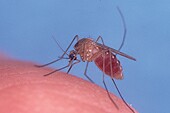
THURSDAY, Sept. 3, 2015 (HealthDay News) — West Nile virus, which first appeared in the United States in 1999, continues to be the most common mosquito-borne illness in the country, federal health officials reported Thursday.
Of 2,327 cases of mosquito-transmitted disease identified in 2014, there were 2,205 cases of West Nile, according to the U.S. Centers for Disease Control and Prevention.
California, Texas and Arizona reported two-thirds of the cases of West Nile, the CDC researchers said.
Most people — an estimated 75 percent — infected with West Nile virus won’t develop any symptoms, according to the CDC.
Less than 1 percent of people will develop a serious neurologic illness, such as encephalitis or meningitis, which is inflammation of the brain or surrounding tissues. Symptoms of severe cases can include headache, high fever, neck stiffness, disorientation, coma, tremors, seizures, or paralysis, according to the CDC.
Infectious-disease expert Dr. Marc Siegel, a professor of medicine at NYU Langone Medical Center in New York City, said fear of a West Nile epidemic is overblown. “It is never endemic among humans. But it does occur in areas where we have a problem controlling the mosquito population,” he said.
About the same number of cases occur each year, Siegel said. “It’s limited by the number of mosquitoes,” he said, adding, “West Nile is not transmittable person-to-person.”
Siegel said that for most people infected with West Nile virus, it appears like a bad flu with fever, headache and muscle ache. Usually, patients are in discomfort for about two weeks, he said.
There’s no treatment for West Nile virus, Siegel said. The most that can be done is to keep the fever down with aspirin or other painkillers and drink plenty of fluids, he said.
Among the West Nile cases in 2014, more than 600 involved encephalitis and over 500 involved meningitis, the CDC researchers found.
“Only in about 1 to 5 percent of the cases do you see full-blown encephalitis,” Siegel said. “So, although everybody thinks West Nile is a killer, it’s not.”
In all, nearly 1,300 people were hospitalized with the virus in 2014 and 87 died, according to the CDC report, published Sept. 4 in the agency’s Morbidity and Mortality Weekly Report.
Report co-author Nicole Lindsey, a CDC epidemiologist, said viruses like West Nile are “continuing to cause substantial illness in a large number of people, so it is important to protect yourself from mosquito bites.”
There is no vaccine yet for West Nile, she said.
While serious illness can occur at any age, those most at risk include people over 60 years of age. Also at risk are those with certain medical conditions, such as cancer, diabetes, high blood pressure, kidney disease and those who’ve had an organ transplant.
West Nile virus was first detected in North America 16 years ago, although it has been present for many years in Europe, the Middle East, Africa, India, parts of Asia, and Australia.
Since 1999, it has spread to the 48 lower states and Canada.
Siegel, like the CDC’s Lindsey, said the only way to prevent getting West Nile virus is to protect yourself from mosquitoes. This means wearing pants and long-sleeved shirts and using insect repellent, he said.
“West Nile is not a growing problem,” he said. “It’s a persistent problem.”
In addition to West Nile, 2014 also saw 80 cases of La Crosse virus, 11 cases of Jamestown Canyon virus, 10 cases of St. Louis encephalitis virus, eight cases of Powassan virus and eight cases of Eastern equine encephalitis virus — other mosquito-borne illnesses.
More information
To learn more about West Nile virus, visit the U.S. Centers for Disease Control and Prevention.
Copyright © 2025 HealthDay. All rights reserved.

